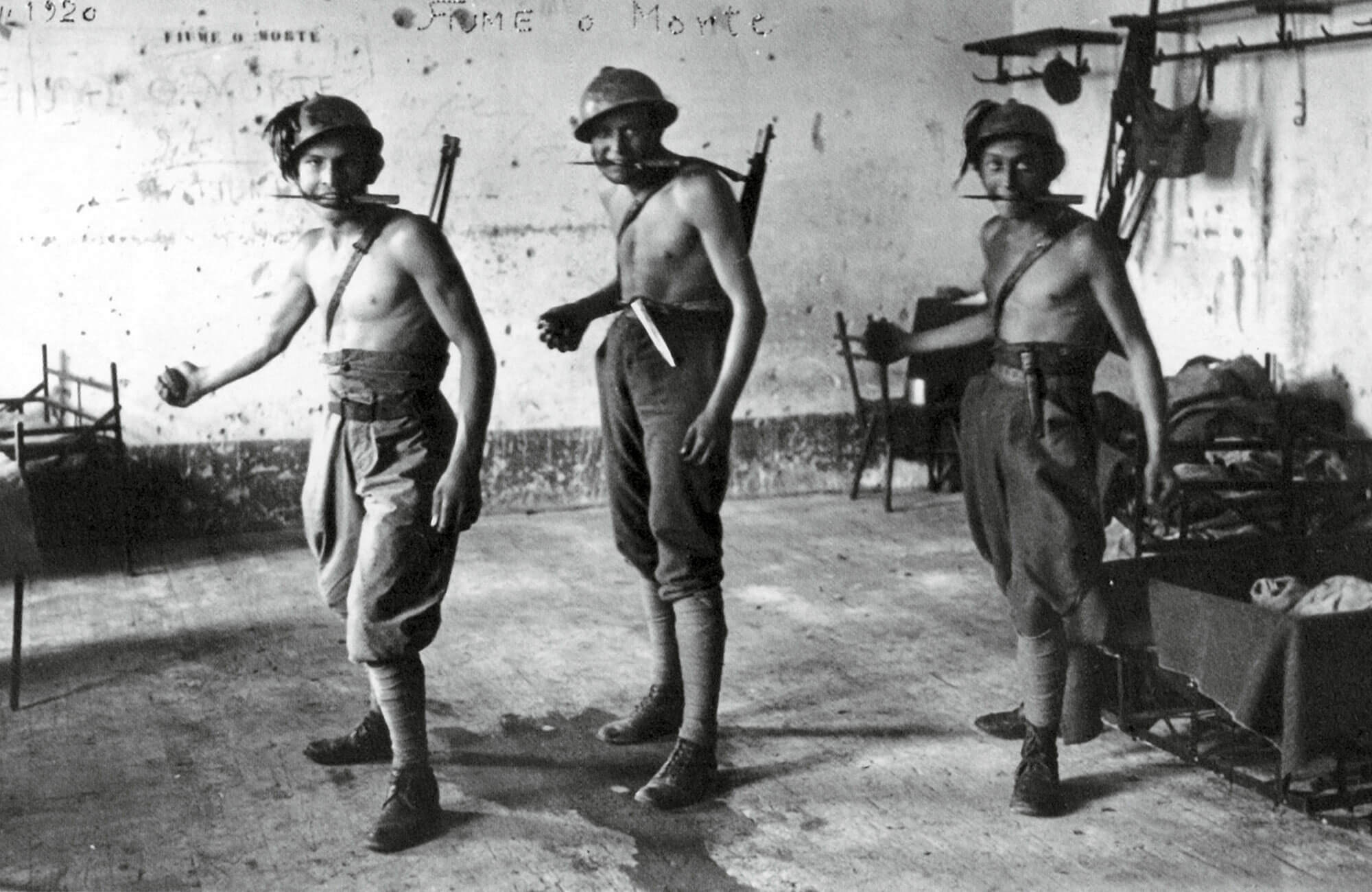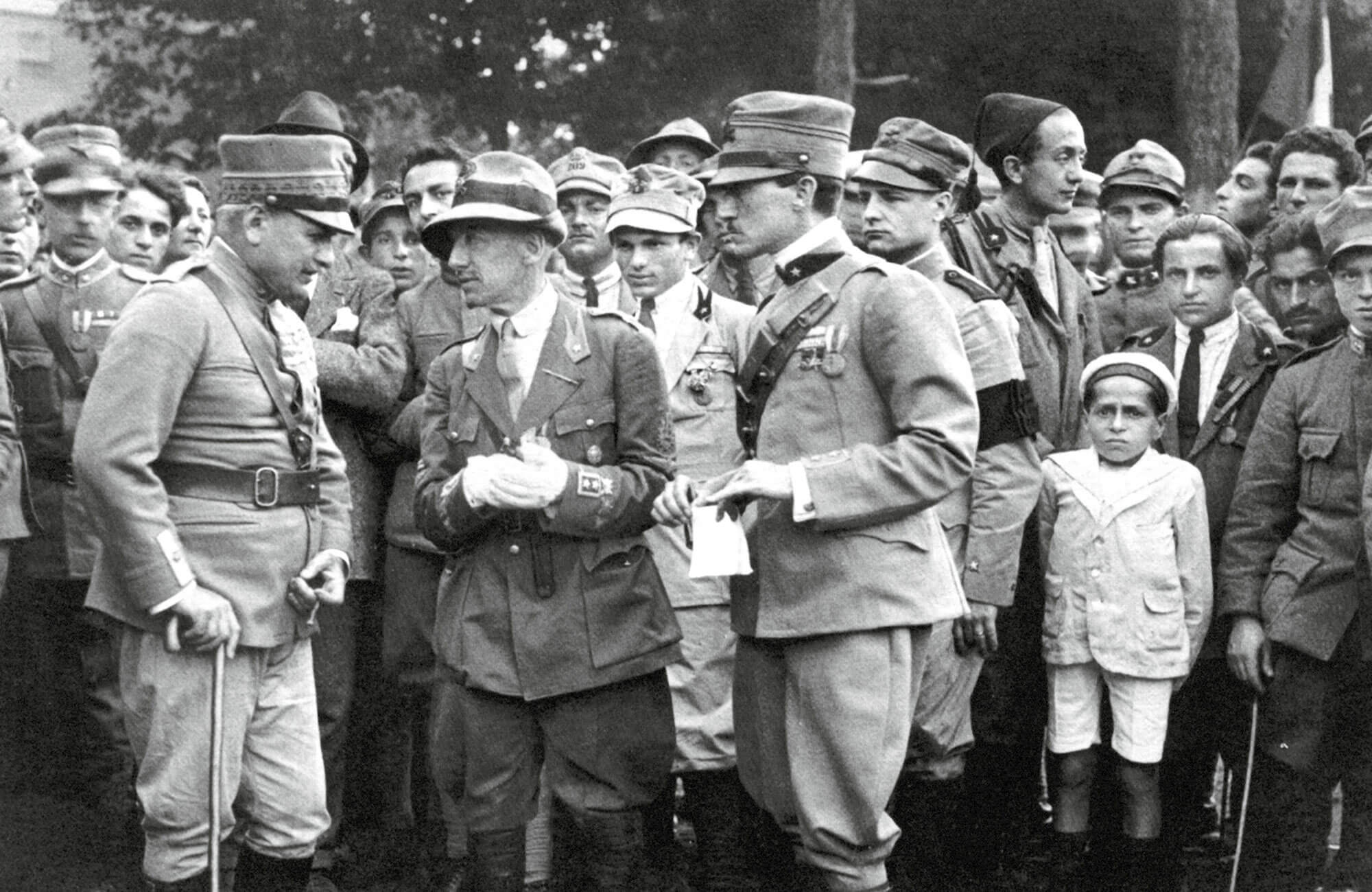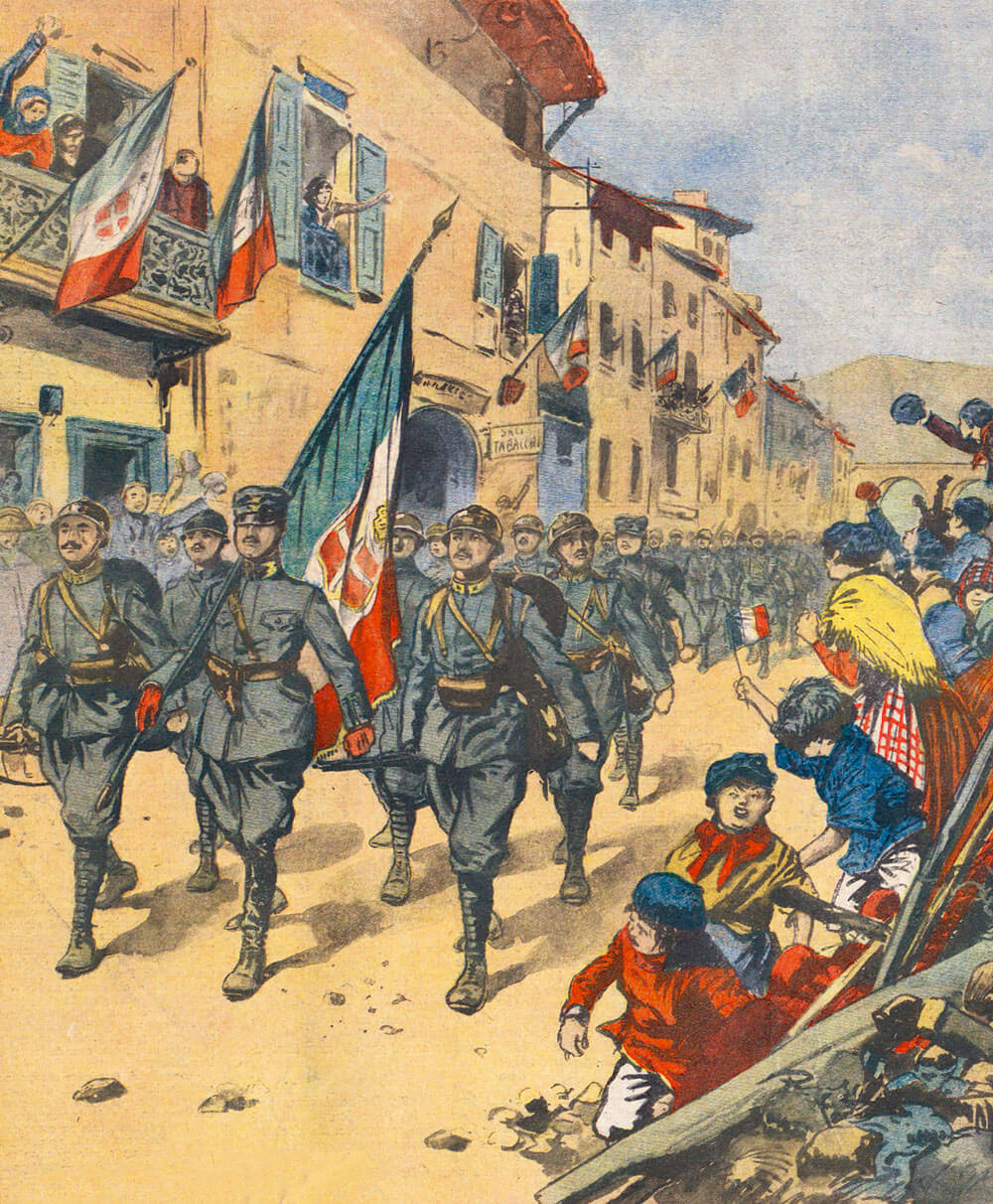A City for Poets and Pirates
Gabriele D’Annunzio and the Fiume adventure
Reinaldo Laddaga

I’ve always found it intriguing that canonical histories of early twentieth-century art and literature, usually so generous in their treatment of the emergence of the historical avant-garde, never mention its most spectacular development: the creation, and ultimate failure, of the so-called Italian Regency of Carnaro. In a certain way, this omission is understandable. What happened between 1919 and 1920 in the contested city of Fiume, when—under the leadership of writer Gabriele D’Annunzio—a peculiar alliance of soldiers, artists, and adventurers occupied the city with the initial intention of annexing it to Italy, complicates the most common narrative in which modern art and progressive politics by nature go together.[1] But, as historian Roger Griffin’s excellent Modernism and Fascism observes, a number of avant-garde movements shared fascism’s aspiration to cure the world (or at least Europe) of anomie and a loss of vitality. These conditions were understood as by-products of modernity, and particularly so at the end of a war that made patent the failure of modernity’s promise of material and social progress. Both movements proposed a return, in the midst of crisis, to a primordial space where the envoys of a new humanity could gather the seeds for a future world. In Fiume, fascists and Dadaists, futurists and Bolsheviks, were, for a few months, in the same camp.
Let’s try to imagine Italy at the end of World War I. A constitutional monarchy the disparate regions of which had only very recently integrated, it had entered the war in 1915 on the side of the British-French alliance one year after the hostilities started, having received from France and England guarantees of territorial compensation. The ensuing three years of combat caused in this mostly traditionalist, agrarian society an even deeper upheaval than the one suffered by its allies. The massive mobilizations for the war, and the replacement of young men in the world of work by women, wrecked not only the basis of the economy but also the structures of prewar society. For some social groups, the expectations of political influence changed: the country’s government had promised new and unprecedented power to its disenfranchised lower classes (a promise that the political class would soon discover it never should have made). The war had been long, and there were young men who did not remember a way of life other than the tough but eminently exciting one they had experienced at the front, where they had died by the hundreds of thousands. The survivors still remembered the bare, dry skeletons in the rocky hills of the Carso, the scene of the most brutal battles, and now they identified their own dignity with the dignity of the nation.


This was true for the entire army, but especially for the assault troops known as the arditi. During the war, the arditi had refused all weapons that would weigh them down: they preferred grenades carried in pockets and daggers held between teeth as they raced toward the enemy trenches, which they rarely reached. They liked to be called “alligators,” were partial to cocaine, and, among them, homosexuality was commonplace. No leader had been able to take for granted the loyalty of these highly volatile men. And now that the war was over, like the German Freikorps, they found no place for themselves in a society where the exhausted majority expected to return to a peaceful civilian life.
We cannot understand the events in Fiume (or the subsequent rise of fascism) without making an effort to imagine a world in which hundreds of thousands of young men who had been promised a share in the spoils of victory returned, after years both frightening and exhilarating—some of them half-blind or deaf, some insomniacs or addicts—to anxious mothers and wives unwilling to listen to their stories, to jobs in industries where bosses worried about productivity. They had known extreme anguish but also fleeting glory, and for a few years had been members of a warrior community where their powers and weaknesses were celebrated and acknowledged. Some of these men formed the core of D’Annunzio’s followers.
And why Fiume? At the end of World War I, a dispute exploded over the fate of the Istrian peninsula. Largely ruled by the Republic of Venice over the centuries, Istria became part of the Austro-Hungarian empire in 1797. In the course of the nineteenth century, Fiume—the largest city on the peninsula—became one of the main ports of the northern Adriatic and the most prestigious resort for the Hungarian elite. The population in the countryside was mostly Slavic, but Fiume had a substantial, thriving Italian community that held the reins of economic power and had been slowly working to restitute the city to what they saw as its motherland. This community was fully justified in assuming that the Allied victory and the dissolution of the Austro-Hungarian Empire represented the crucial occasion to achieve this goal: in the negotiations preceding Italy’s entry into the war, Great Britain and France promised to transfer Istria to the Italian government. Instead, the Versailles conference of 1919 sanctioned the formation of a new nation—the Kingdom of Serbs, Croats, and Slovenes, later Yugoslavia—whose territory, it now seemed, would include Istria. For the Italians in Fiume, this awful prospect was due to the incompetence and weakness of the Italian negotiators and had to be immediately corrected by the use of force. For the demobilized soldiers who roamed the country without any particular destination or place in bourgeois society, and for men like Gabriele D’Annunzio, Benito Mussolini, and Filippo Tommaso Marinetti, this denial of the fruits of victory was the most intolerable of humiliations. Talks started between the Italianists in Fiume and some of the new political leaders emerging in the ruins of postwar Italy. This is where D’Annunzio enters the story.
Gabriele D’Annunzio was the most prestigious Italian writer of the late nineteenth century. He was the author of realist novels, symbolist theater pieces, peculiar collections of poems, and exalted psychosexual melodramas. He had lived a life of luxury in Rome, Naples, Florence, and Paris, and wrote a work of musical theater, The Martyrdom of Saint Sebastian, which was scored by Claude Debussy. But by the early 1910s, he probably felt that he was past his prime. This must have been at least part of the reason why he saw—and he was not alone in this—the war as the opportunity for a great renewal. By then in his fifties, he surprisingly became an aviator and, after a dazzling series of incursions into enemy territory, a war hero. He lost an eye in battle, but even this affliction was the occasion to write an eminently modern book called Nocturne. To the young, he was proof that the old Italy was still capable of magnificent exploits. It is also understandable that he feared that now that the fighting had ended, his personal decline of the prewar years would resume. He considered various options, including leading a march to Rome to overthrow the present government and undertaking an unprecedented, heroic flight from Venice to Tokyo—anything, except returning to the calm of his life as a fading, middle-aged writer. He began to make explosive speeches that called for the return of the great glory of Italy. He announced and demanded a conflagration that would restore the spiritual authority of the country. He thought that the loss of Fiume would have a profound symbolic dimension and that it was vital to recover the city.
It seemed to Fiume’s Italian elite that they had found their leader. D’Annunzio had developed connections with the arditi in Venice during the war and had shown himself perfectly capable of eliciting extraordinary enthusiasm in his followers. In September 1919, a band of a few hundred ex-combatants marched under his command toward Fiume. No one stopped them; on the contrary, the Italians among the Allied troops charged with guarding the city joined their cause. They entered Fiume, whose non-Slavic population initially received with euphoria the arrival of this strange leader who had never governed before, who had the vaguest political ideas, and who seemed to be mostly occupied in the tiring task of self-glorification. He professed a deep admiration for his young followers and gave endless speeches calling Fiume “the city of the Holocaust,” the place where the old world was going to end and still-unheard-of ways of life would develop.
The initial plan, however, was more modest: D’Annunzio intended to repatriate Istria to Italy. But the Italian government, which had accepted the resolutions made at Versailles, had no interest in this gift. The project soon began to mutate: if the Italian regime in power was too corrupt and cowardly—too easily dominated by the Americans and their sidekicks, the old Europeans—then the example of the troops at Fiume would unchain a mass movement that would overthrow it, and perhaps even elevate D’Annunzio to the position of leader of the nation. None of this happened. Instead, a tense standoff began. The embarrassed Italian government convinced the Allies that it would deal with the situation, which it argued was an internal matter. But lacking confidence in its own army, Italy didn’t attempt to take Fiume; rather, it instituted a partial siege, with the intention of keeping the revolt from expanding without entirely asphyxiating the population. Four months later, in December 1919, the Italian government presented to the National Council, which was the organ of the Italian community at Fiume, a formal declaration that it would work to impede the annexation of the city to the Kingdom of Serbs, Croats, and Slovenes, and a guarantee of either its annexation to Italy or, if this was not possible, its autonomy. This seemed good enough for the Fiumean citizens, who were not as convinced as before of the virtues of their new leader, and decided to accept it. But D’Annunzio was unwilling. Not yet. Perhaps never. Nor were the more radical youth who seconded him ready to abandon what they had begun to call the “City of Life.”
From the beginning, the coexistence of the diverse groups that gravitated around D’Annunzio had been difficult. There were the citizens of Fiume and the Italian troops (the arditi, the carabinieri), but also Bolsheviks who rushed to the city (in a Moscow speech, Lenin said he and D’Annunzio were the only authentic revolutionaries of Europe); anarcho-syndicalists; futuristic, fascist Dadaists; and oddities like the curious war hero Guido Keller, whose mascot was an eagle, who slept naked in the tops of trees, and who was one of the new commander’s main lieutenants. The universe around the leader quickly fragmented into factions. Forced to take sides, D’Annunzio came to rely mostly on the young artists, anarchists, and arditi who constituted the radical wing of the grand alliance of Fiume, and who formed the “Union of Free Spirits Tending Toward Perfection” (or, as they nicknamed it, “Yoga”). The group shared an enthusiasm for Hinduism, spiritual aristocracy, nudism, and for building an agrarian utopia where preindustrial forms of life would be restored. Subgroups were formed: the Brown Lotuses, who wanted to lead a simple life and professed a return to nature; the Red Lotuses, who proclaimed the arrival of a new world transfigured by a renewed sexuality; and a group who identified themselves as the followers of a still-undefined “Sacred Love.”

The fate of the utopia that this group was pursuing became increasingly dire as the isolation of Fiume became more profound: from the beginning of 1920, food became increasingly scarce, and it became harder to find the fabric needed for the confection of ever-more-flamboyant uniforms for the city’s soldiers and ever-more-splendid flowers for their festivals. But, according to all accounts, the atmosphere in Fiume remained more or less that of a continuous party, partially fueled by the drugs that the arditi had become addicted to on the battlefield and to which their leader was now also addicated. It was a “Bal des Ardents,” a dance of the burning, said the Belgian poet Léon Kochnitzky, one of D’Annunzio’s closest aides. At the festival of San Vito, he continued, “one’s gaze, wherever it fixed, saw a dance: of lanterns, of sparks, of stars, starving, in ruin, in anguish. Perhaps on the verge of death in the flames or under a hail of grenades, Fiume, brandishing a torch, danced before the sea.”[2] The regime was increasingly sustained by pirate raids of various kinds, and by the fruits of the burgeoning drug trade. The warships moored in the port at the time of the occupation were used to capture merchant ships along the Adriatic coast, between Messina and Trieste. Groups of rebel soldiers stole horses, weapons, and food from Italian garrisons in the countryside. But medicine and food for the children was still lacking, and D’Annunzio ordered scores of babies to be sent to Italy and given away for adoption. The contrast between the euphoria of the young and the increasing desperation of the local bourgeoisie intensified.
The city had become a magnet for radicals. One, who arrived in 1920, was the prominent syndicalist Alceste De Ambris, an active figure in the workers’ movement and founder of the Fasci d’Azione Rivoluzionaria Internazionalista, which would eventually merge with other fasci led by Benito Mussolini. De Ambris became D’Annunzio’s chief of staff and started working on a constitution for a new state, which they named the Italian Regency of Carnaro (the traditional Italian name for the region surrounding the city). The Charter of Carnaro is an extraordinary document. The ideas at its base are mostly those we would expect from a revolutionary syndicalist, not surprisingly given that De Ambris was responsible for the first draft of the document. The text states from the beginning that it will be “a government elected by the people—res populi—founded on productive work, and its ordering principle is inspired by the most generous and diverse forms of autonomy as they were understood and exercised in the four glorious centuries of our communal period.”[3] The constitution attempts to maintain a balance between the recognition of the equality and diversity of citizens (because “the harmonic interplay of diversity makes stronger and richer the common life”) and the intention to “widen, expand, and hold the right of the workers above any other law.” The document restricts private property, which is not entirely eliminated but is subordinated to the good of the community. Work is idealized as an activity that elicits “the feeling of virtuous joy” that should be the dominant mood of citizens and is located at the center of the three “religious beliefs” that the constitution enshrines:
Life is beautiful and worthy of being severely and magnificently lived by a man rebuilt entirely by freedom;
The complete man is one who knows how to exercise every day his own virtue to offer every day his brothers a new gift;
Work, even the humblest, even the most obscure, if done well, tends to beauty and ornates the world.
This state of the citizen-worker is organized around corporations, designed on the model of labor unions. The charter prescribes the formation of nine corporations consisting, respectively, of factory workers, technicians, managers, public officers, merchants, farmers, students and teachers, professionals, and sailors, and a tenth, supplementary one that is vaguely defined and most peculiar.[4] The executive branch that presides over them must be as fluid and transitory as possible; the judiciary must encourage the citizens to settle their accounts, whenever possible, without the intervention of the courts; legislators should meet just a few times a year.
But the baroque prose of the final document belongs, unequivocally, to the poet-leader who finalized De Ambris’s draft. In addition to the brilliant and occasionally convoluted character of the text, it’s probably due to D’Annunzio that the pillars of the Free University placed at the top of the regency’s educational structure are a School of Fine Arts, a School of Decorative Arts, and a School of Music. Also to him must be due the disproportionate attention paid by the charter to the institution of an Office of Aldermen composed of “men of pure taste, exquisite skill, and of the newest education.” Their work was to ornament streets and squares “with that same musical sense that guides the creation of … republican pomp or of a carnival representation,” prepare the civic festivals, and educate the people in the love of forms and colors, especially when they are incorporated into the “vivid and powerful utensils” that are deployed in daily life. And perhaps it was also due to D’Annunzio that the charter declared music the highest of all the city’s arts. From their first day in school, children would be taught “choral singing founded on the basis of the most naive peasant poetry,” because music announces the realm of spirit and gives a glimpse of the dawn of a new kind of freedom. And they would learn to appreciate not only the music produced by voices and instruments, but also the one produced by tools used in work and by machines that roar following their own mysterious rhythm. These are the last lines of the charter:
Choral and instrumental bodies subsidized by the state are instituted in all the Communes of the Regency.
The College of Aldermen is entrusted with the task of building a rotunda capable of holding at least ten thousand listeners, with comfortable seats for the people and a vast pit for the orchestra and the choir.
Large choral and orchestral performances are totally free, as the Church Fathers said of God’s graces.
When we read the charter, written in the first half of 1920 and proclaimed (to the dismay of the local bourgeoisie) in July of that year, we realize that Fiume had undergone, in the course of just a few months, a profound mutation. It was initially intended to bring about a change in Italian policies, but now that this initial plan had failed, D’Annunzio, De Ambris, Kochnitzky, and Keller saw it as a place where a profound restructuring of global politics would begin. Now they conceived of the regency as the beginning of a movement where Italians, Serbs, Egyptians, Turks, Indians, Irish, and others would revolt against the domination of capitalism, of imperialism, of all forms of decay. Therefore, they decided to establish a League of Oppressed Peoples to carry out this magnificent task and bring to Fiume a number of delegates to start the discussions meant to give a specific form to, ultimately, world revolution, of which a great uprising in the Balkans would be the first step.
But it was too late: the economic and political crisis had become too deep. The rewards of piracy were not sufficient to keep the city functioning. The links between the circle of the leader and the institutions of bourgeois community (with the National Council at the center) had broken. Those factions of the army attracted by the nationalist program of 1919 started to leave. D’Annunzio, who from the beginning had oscillated between supporting the most extreme plans of his left wing and acting to win the confidence of the most conservative elements of his strange coalition, became increasingly erratic. Even some of his closest collaborators, who could now rarely see him, locked in as he was in his suite at the Hotel Europe, began to doubt him.

The Fiume adventure ended in the last days of 1920 in an anticlimactic way. The Treaty of Rapallo, which settled the relations between Italy and the Kingdom of Serbs, Croats, and Slovenes, granted full autonomy to the city. It could be supposed that D’Annunzio, politically defeated, would then have given up the struggle and abandoned Fiume, but he didn’t. Neither the first of his goals (the annexation of Istria to Italy) nor the second (the creation of a political entity of a new type) met, he refused to recognize the validity of the treaty. An Italian assault on the city in late December 1920 (Bloody Christmas is the name that tradition would give those days) overcame remaining occupant troops—by now in full disarray—in exactly two days.
Many of the demobilized soldiers who had supported D’Annunzio were soon to become the most devoted and active members of the emerging fascist movement. As for the poet himself, he would spend the last years of his life in splendid confinement in a villa on Lake Garda. He was honored, materially supported, and publicly celebrated by the fascist regime, but it was understood that his political life was over. His literary work was essentially completed too: he spent the rest of his life editing, reordering, and monumentalizing what he wrote in his first five decades, and died in 1938. His most enduring legacy as a public figure was perhaps the development of a kind of political spectacle that would be perfected by the infinitely more somber Benito Mussolini and Adolf Hitler.
See press about “A City for Poets and Pirates” in Arts and Letters Daily.
- In English, the only book-length account of the story is Michael A. Ledeen’s The First Duce: D’Annunzio at Fiume (Baltimore and London: The John Hopkins University Press, 1977). The story is also told, in a more fragmentary manner, by Lucy Hughes-Hallet in her biography of D’Annunzio, Gabriele d’Annunzio: Poet, Seducer, and Preacher of War (New York: Knopf, 2013).
- Quoted in Michael A. Ledeen, The First Duce, p. 151.
- Unless otherwise indicated, all translations are my own.
- The tenth corporation, says the text, has no art or categories or vocabulary. Its fulfillment is anticipated as that of the tenth Muse. Reserved for the mysterious powers of the people at work and in ascension, it is a votive figure devoted to the unknown genius, the apparitions of the new man, the ideal transfiguration of the labors and days, the complete liberation of the spirit from painful breath and bloody sweat. It is represented in the civic sanctuary by a burning lamp that is inscribed with an ancient Tuscan expression from the age of the Communes, which splendidly alludes to a spiritualized form of human work: Fatica senza fatica (“effort without fatigue”).
Reinaldo Laddaga is an Argentine writer and critic who lives in New York. He is the author of Things That a Mutant Needs to Know (Unsounds, 2013) and co-editor, with Jorge Carrion, of Riplay (Adriana Hidalgo editora, 2014), a collective Spanish-language rewriting of Robert Ripley’s Believe It or Not. He is currently working on a book on the parallel lives of Gabriele D’Annunzio and Max Beerbohm.
Spotted an error? Email us at corrections at cabinetmagazine dot org.
If you’ve enjoyed the free articles that we offer on our site, please consider subscribing to our nonprofit magazine. You get twelve online issues and unlimited access to all our archives.